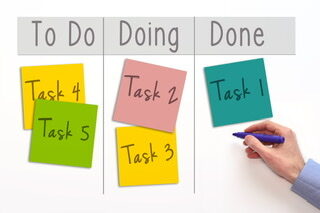Life in Lockdown

Many of us have spent the last weeks sheltering-in-place. We’ve made our lists of things we want to accomplish and to make the most of this time. Some of us have created our own personal Kanban Boards (guilty!). We’ve also collectively experienced a certain amount of malaise and lack of focus, as each day runs into the next. Life in lockdown has had very little to break up the monotony. My personal experience in this time has given me some Lockdown Lessons, I would like to share as they have been great reminders of Agile values, practices, or principles. I learned this lesson on limiting WIP (work in progress) while making face masks.
Small Batches, Limit WIP
As an Agile Coach, I coach teams and leaders to ensure that they break work into small batches and limit WIP. With this lesson, I usually get looks that say:
- ”You’re kidding, right?.”
- “That’s not efficient for me.”
- “Won’t work here, our code is too complex.”
- “Yeah, sure.”
My clients quickly follow these looks (and outright statements!) with a request for “real-world” examples. Happily, I share examples, yet most often do not overcome resistance until a few sprints later. Once the team has lived with carry-over work and missed sprint goals, the concept is now concrete.
Lockdown Example: Making Face Masks
To do my part, I adapted my dog bandana-making skills into sewing face masks. I wanted to ensure my husband, family, and friends have available options that would not interfere with needed equipment for front-line workers dealing with the public. An unfortunate reality in our current lives. Applying Agile practices, I first tried an experiment and made one mask. That taught me a lot about how I could construct the masks much easier. My husband wore that one to work and it worked well. Now, time to persevere and make more.
Optimizing for Part of the Whole
Having no elastic, I had to make the ties from fabric. I found this to be the most fiddly bit, with cutting, pressing, stitching, tying threads, trimming, and turning. I enjoyed It the least and would have put it off until last, except they needed to be constructed first, as I sew them into the mask from the inside.
After my experiment, my approach devolved into cutting all the fabric, making all the ties (ugh – four per mask!), attaching the ties, and finishing the mask. Sounds pretty efficient! Except that for days (due to lockdown lack of focus and procrastination), I had a bunch of components, but no finished masks. My husband wound up using the one experimental mask for a couple of days and washing it. I was really getting nowhere fast! Then it hit me — I created too much WIP and wasn’t focused on finishing!
Optimizing for the Whole
I changed my approach and focused on finishing one mask at a time. Yeah, I had to do smaller amounts of unpleasant fiddly bits more often. That actually took less time than doing a marathon of fiddly bits and made that part less unpleasant. Also, I didn’t have a lot of lag time waiting for the iron to warm up. It was always warm, as I would press, sew, press, trim, press, etc. My family and friends had a fresh mask (at least) available each day. Now, we were getting somewhere!
Tying To Agile
Traditional Delivery
Think of delivering a batch of face masks as a feature. In traditional delivery, we would breakdown this feature into stories such as:
- Cut fabric
- Press fabric
- Make ties
- Sew mask base
- Attach ties
- Make pleats
- Finish mask
This approach creates stories that people with specialized skill sets work on alone. However, we wind up with a bunch of unfinished components, WIP, and no usable masks. Think of the iron lag time as QA, waiting for code delivery and getting it a few days before the end of the sprint. QA must unnecessarily turn the iron up hotter than needed to quickly get to temperature, while running the risk of burning (out!). Meanwhile, my family (the customer) is going without masks.
Agile Delivery
Using an Agile approach, we break the stories down into usable customer value (below) and swarm to complete an entire mask as one story:
- Monday mask
- Tuesday mask
- Wednesday mask
- Etc.
Under each story, we could have tasks for cutting, pressing, sewing, etc. The team swarms on one story, using T-shaped skills to complete tasks. More than likely, we would complete more than one mask a day and exceed our customer’s (my family) expectations.
Summary
This experience gives me another real-world, if unfortunate, example to share when training or coaching teams on the Agile practices of small batches and limiting WIP. I hope it has resonated with you, too. The experience also reminded me to have empathy with my coaching clients going forward. It was so easy, even for an Agile Coach, to slip back into an approach that optimized the parts, instead of the whole. What a great reminder!
Until we can be together again…be well.